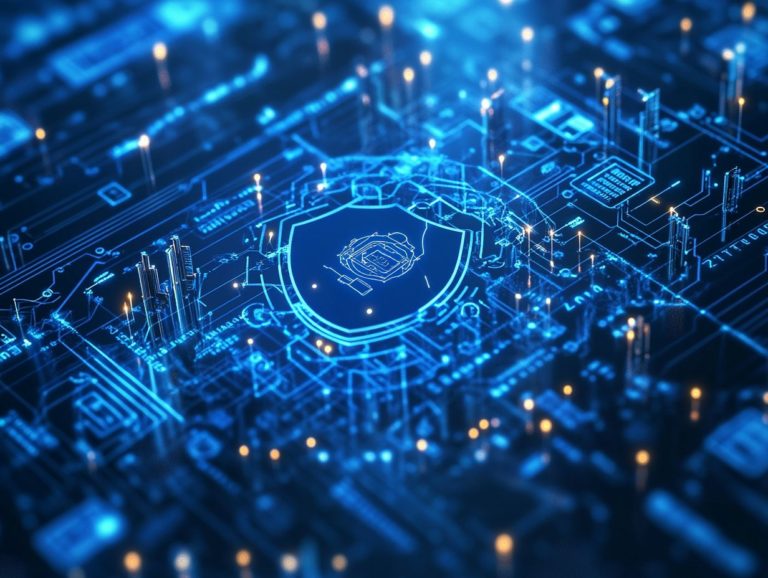building a cybersecurity compliance checklist
In today s digital landscape, protecting sensitive information is critical. Establishing a strong compliance plan is essential for navigating the complexities of cybersecurity.
This checklist will help you define your compliance objectives and assess your current measures.
From understanding relevant laws to crafting effective incident response plans, every step is vital for maintaining security against evolving threats. Elevate your cybersecurity strategy to ensure compliance with necessary standards.
Contents
- Key Takeaways:
- 1. Define Your Compliance Objectives
- 2. Identify Relevant Laws and Regulations
- 3. Assess Your Current Cybersecurity Measures
- 4. Create a Risk Management Plan
- 5. Develop a Security Policy
- 6. Implement Access Controls
- 7. Train Employees on Cybersecurity Best Practices
- 8. Regularly Update Software and Systems
- 9. Conduct Regular Security Audits
- 10. Establish Incident Response and Disaster Recovery Plans
- 11. Monitor and Respond to Security Threats
- 12. Documentar y mantener registros de cumplimiento
- 13. Regularly Improve Your Compliance Measures
- 14. Get Ready for Future Regulations
- 15. Seek Professional Assistance if Needed
- Frequently Asked Questions
- What is a cybersecurity compliance checklist and why is it important?
- What are the key components of a cybersecurity compliance checklist?
- How can I build a cybersecurity compliance checklist for my organization?
- What are the consequences of not having a cybersecurity compliance checklist?
- What are some best practices for building a cybersecurity compliance checklist?
- Can a cybersecurity compliance checklist guarantee complete protection against cyber threats?
Key Takeaways:

Clearly define your compliance objectives to ensure a focused and effective checklist.
Identify and stay updated on relevant laws and regulations to ensure full compliance.
Regularly assess and improve your cybersecurity measures to stay ahead of potential threats.
1. Define Your Compliance Objectives
Defining your compliance objectives is an essential first step in crafting a solid cybersecurity strategy. This not only aligns with regulatory requirements but also addresses the specific risks your organization faces. To get started, consider what you should know about cybersecurity compliance.
This proactive approach ensures effective data protection and minimizes the risk of security breaches. A well-articulated compliance plan acts as your roadmap, guiding the implementation of necessary security policies and facilitating thorough risk assessments.
Every team member should understand their role in upholding cybersecurity regulations.
To effectively pinpoint these compliance objectives, closely examine industry standards like the General Data Protection Regulation (GDPR) and the Health Insurance Portability and Accountability Act (HIPAA). Dive deep into the specific legal requirements these regulations impose, and understand how they relate to your organization’s operations and data handling practices.
Aligning your compliance objectives with organizational goals can significantly mitigate potential threats by ensuring resources are allocated efficiently.
Conducting comprehensive risk assessments will help uncover vulnerabilities and clarify how compliance aligns with your organization’s mission and vision. This ultimately fosters a culture of security awareness among all employees.
2. Identify Relevant Laws and Regulations
Identifying relevant laws and regulations is crucial for developing a compliance plan that meets necessary cybersecurity standards. This is especially important as you navigate the complexities of regulations such as the General Data Protection Regulation (GDPR), Health Insurance Portability and Accountability Act (HIPAA), California Consumer Privacy Act, and Payment Card Industry Data Security Standard.
Understanding the specific mandates of these laws will significantly influence your cybersecurity framework management. For example, GDPR places a strong emphasis on individual data rights, requiring robust data protection measures. Meanwhile, HIPAA outlines strict protocols for safeguarding patient information.
Each of these regulations sets compliance requirements and highlights the need for thorough risk assessments and comprehensive security policies. To stay ahead of potential issues, it’s crucial to learn how to avoid compliance pitfalls in cybersecurity. As technology and cyber threats evolve, prioritize regular updates and continuous compliance monitoring.
This proactive approach will help you stay ahead of shifting legal landscapes, ensuring your cybersecurity practices are not just adequate but truly resilient.
3. Assess Your Current Cybersecurity Measures
Assessing your current cybersecurity measures is essential for identifying vulnerabilities and gaps in data protection. This enables you to develop effective security policies and a robust incident response strategy to mitigate risks.
You can employ various assessment methods, such as conducting thorough vulnerability assessments that examine both internal and external weaknesses within your systems.
Reviewing incident logs provides invaluable insight into past security breaches, allowing you to analyze response effectiveness and refine your strategies.
Incorporating frameworks from the National Institute of Standards and Technology can enhance this process, offering a structured approach to benchmark your security practices against established industry standards. This ensures you not only meet but exceed basic compliance requirements.
4. Create a Risk Management Plan
Creating a comprehensive risk management plan is crucial for mitigating cybersecurity threats. It ensures that your compliance objectives and incident response strategies are clearly defined.
This process starts with identifying potential risks that could impact your operations, such as data breaches and system failures.
Once you ve pinpointed these risks, evaluating their potential impact becomes vital. This includes assessing both the likelihood of occurrence and the severity of their consequences.
From there, you can implement robust controls, incorporating technological solutions and staff training to minimize your risk exposure.
Regular reviews are a game-changer for your cybersecurity strategy! They ensure your plan remains effective against new and evolving threats and aligns with changing compliance requirements.
Regular updates not only strengthen your defense mechanisms but also enhance your organization’s overall resilience.
5. Develop a Security Policy

Developing a robust security policy is essential for establishing clear guidelines on data protection, access control, and incident response. This ensures that every employee is trained to uphold cybersecurity standards and fully understands their responsibilities.
An effective policy should include key components such as acceptable use policies, which dictate how devices and data can be utilized, along with access control measures that determine who can view or modify sensitive information.
To enhance security, outline protocols for incident response that provide immediate actions during a breach. This minimizes damage and facilitates recovery.
Regular training sessions are vital to keep your workforce informed about evolving threats and compliance requirements, fostering a culture of security awareness. By implementing these elements, your organization can maintain a proactive stance against cyber vulnerabilities.
6. Implement Access Controls
Implementing access controls is essential for safeguarding sensitive information. It ensures that only authorized personnel can access critical systems and data.
By utilizing measures such as encryption and multi-factor authentication (a security method requiring two or more verification methods to access data), you significantly enhance overall data protection.
Organizations often adopt various types of access controls tailored to their unique environments. Role-based access control (RBAC) assigns permissions based on an individual s job responsibilities, streamlining the access-granting process and minimizing potential risks.
Adhering to the principle of least privilege allows you to restrict users to the minimum necessary access required for their tasks. This effectively reduces the chances of unauthorized actions.
By incorporating these strategies, you can substantially mitigate risks associated with insider threats and unauthorized access, fortifying your security policies and ensuring compliance with industry regulations.
7. Train Employees on Cybersecurity Best Practices
Training your employees on cybersecurity best practices is essential for cultivating a robust culture of security awareness. It equips them with the skills needed to identify threats like phishing attempts and adhere to established security policies and incident response protocols.
This training covers crucial topics, including how to spot suspicious emails, the importance of timely incident reporting, and the need for meticulous adherence to security protocols.
As cyber threats continuously evolve, ongoing education becomes vital. It enables your team to stay abreast of the latest tactics employed by cybercriminals.
Understanding compliance with regulatory requirements ensures that everyone is proactive in their protection efforts, effectively contributing to the organization s overall security posture.
By fostering an environment of continuous learning, your workforce will be well-positioned to adapt and respond to emerging risks, enhancing resilience against potential cybersecurity breaches.
8. Regularly Update Software and Systems
Regularly updating your software and systems is crucial for maintaining strong cybersecurity.
It helps patch vulnerabilities and integrate the latest technical controls, ensuring effective monitoring of compliance with security policies and protection against cyber threats.
These updates often include critical patches for operating systems that fix security holes exploited by attackers.
Application updates enhance functionality and usability.
By applying these updates promptly, you can significantly reduce the risk of data breaches and prevent unauthorized access.
Timely updates also improve overall system performance, optimizing user experience.
Neglecting these updates can leave your systems exposed, creating openings for cybercriminals.
Therefore, regular software maintenance is a cornerstone of any robust cybersecurity strategy.
9. Conduct Regular Security Audits
Conducting regular security audits is essential for organizations to evaluate cybersecurity measures.
This ensures compliance with regulations and identifies areas needing improvement.
The process starts with careful planning, where your organization’s specific needs and potential vulnerabilities are assessed.
This involves assembling a team of cybersecurity experts to define the audit’s objectives and scope.
Once planning is complete, it s time to execute the audit.
This includes comprehensive assessments of your existing security protocols, practices, and technologies.
It’s a hands-on process critical for uncovering gaps or weaknesses that may expose your organization to threats.
After the audit, findings are compiled into a detailed report.
This report highlights existing issues and offers actionable recommendations to enhance security measures.
Adopting this thorough approach is vital for keeping pace with the evolving landscape of cyber threats.
10. Establish Incident Response and Disaster Recovery Plans

Establishing strong incident response and disaster recovery plans is vital for quickly tackling security breaches.
This ensures you minimize damage and restore operations while staying compliant with cybersecurity regulations.
Your plans should clearly outline the roles and responsibilities of each team member.
This ensures everyone knows exactly what to do during a crisis.
Effective communication strategies are essential; established channels allow you to quickly share information with stakeholders and coordinate efforts smoothly.
Recovery strategies must detail the precise steps needed to restore systems and data after an incident.
Additionally, continuous training and simulations are crucial; they improve your team’s preparedness and highlight gaps in your plan.
This leads to ongoing improvement and greater resilience against future threats.
11. Monitor and Respond to Security Threats
Monitoring and responding to security threats in real-time is crucial for maintaining your organization’s cybersecurity effectiveness.
This proactive approach allows for the prompt identification of threats and swift implementation of necessary steps to handle incidents.
To achieve this, you can leverage various methods and tools, such as intrusion detection systems (IDS).
These tools continuously analyze network traffic for suspicious activities.
Security information and event management (SIEM) systems are also very useful; they collect and analyze logs from multiple sources.
This provides a centralized view of security events.
By adopting these measures, you significantly enhance your ability to swiftly detect potential threats.
This leads to quicker reaction times and reduces the risk of data breaches or other security incidents.
Safeguarding your organization s reputation and assets is paramount.
12. Documentar y mantener registros de cumplimiento
Keeping compliance records shows you follow cybersecurity rules. This helps you effectively respond to audits and uphold overall audit compliance within your compliance plan.
In this context, having a robust collection of documentation is imperative. This should include various types such as:
- Incident logs that capture specific cybersecurity threats and the responses enacted,
- Policy documents that clearly articulate your organization s security protocols,
- Comprehensive training records that highlight employee awareness and preparedness.
By meticulously keeping these records, you enhance your ability to monitor ongoing compliance and strengthen your incident response strategies. Easily accessible documentation can streamline processes during critical moments.
This holistic approach to record-keeping fosters a culture of accountability and vigilance, setting the stage for effective compliance management.
13. Regularly Improve Your Compliance Measures
Regularly improving your compliance measures is crucial for adapting to emerging cybersecurity threats. This ensures your compliance plan effectively manages risk assessments and vendor management practices.
This proactive approach aids in identifying potential vulnerabilities and aligns your organizational practices with the latest regulatory frameworks.
As the digital landscape evolves, it s imperative for you to stay vigilant regarding changes in laws and industry standards.
Establishing feedback loops allows you to gather insights from various stakeholders, promoting an environment of open communication and collaboration.
By embracing continuous improvement methodologies, you enable stakeholders to refine processes, ensuring a robust response to new challenges.
Investing in regular reviews and updates positions your organization to better safeguard sensitive information and maintain trust with clients and partners alike.
14. Get Ready for Future Regulations
Get ready for future regulations to stay compliant and safeguard against evolving cybersecurity challenges. By ensuring your compliance plan is proactive and adaptable, you position yourself to meet new regulatory requirements with confidence, guided by resources like cybersecurity compliance: a guide for businesses.
To navigate these complexities effectively, prioritize establishing strong relationships with legal advisors who can provide real-time insights on emerging legislation and offer tailored guidance specifically for your organization.
Engaging actively with industry groups can facilitate open dialogues about best practices and highlight shared concerns. This collaborative approach enriches your understanding of potential shifts in the regulatory landscape.
Integrating flexibility into your compliance strategies allows you to adapt swiftly to new standards while promoting resilience amidst continuous changes. This proactive stance safeguards against potential risks and ensures a robust compliance framework that stands the test of time.
15. Seek Professional Assistance if Needed

Seeking professional assistance when needed can greatly elevate your organization’s cybersecurity posture. This ensures that your compliance plan is both comprehensive and in line with best practices and regulatory requirements, especially with insights from legal advisors and cybersecurity incident response checklists and experts.
You often face complex challenges that may surpass your internal capabilities, making it essential to bring in external expertise. By hiring consultants or legal advisors, you can tap into specialized knowledge in compliance, risk assessment, and incident response, which can prove invaluable during regulatory audits or in the wake of data breaches.
Good vendor management adds security to your organization, allowing you to access advanced tools and techniques that may not be available in-house. By investing in these resources, you strengthen your defenses and cultivate a culture of continuous improvement in your cybersecurity practices.
Frequently Asked Questions
What are compliance records?
Compliance records are documents that demonstrate your organization’s adherence to cybersecurity regulations.
Why is it important to seek professional assistance?
Professional assistance is important for navigating complex regulatory requirements and enhancing your cybersecurity posture.
What is a cybersecurity compliance checklist and why is it important?
A cybersecurity compliance checklist outlines the security measures an organization must follow to comply with laws, including key regulations for cybersecurity compliance. This helps protect sensitive data and assets from cyber attacks.
What are the key components of a cybersecurity compliance checklist?
Key components include risk assessment, access control, and network security. These elements help create a strong security level.
How can I build a cybersecurity compliance checklist for my organization?
Start by identifying relevant laws for your industry. Conduct a risk assessment and involve all stakeholders to develop effective procedures.
What are the consequences of not having a cybersecurity compliance checklist?
Without a checklist, organizations are vulnerable to cyber attacks, which can lead to fines and reputational damage. Understanding the evolution of cybersecurity compliance can help mitigate these risks.
What are some best practices for building a cybersecurity compliance checklist?
Involve all stakeholders and conduct regular assessments. Keep the checklist updated and ensure employees receive training.
Can a cybersecurity compliance checklist guarantee complete protection against cyber threats?
A checklist can’t guarantee total protection but can reduce the risk of cyber attacks. To stay ahead, it’s important to understand the future of cybersecurity compliance, as ongoing monitoring and updates are essential.






